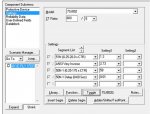- Location
- Lockport, IL
- Occupation
- Retired Electrical Engineer
I need a translator, or at least an instructor. I have gone through the exercise of comparing a set of fuse curves and an MV cable's damage curve. I now need to check the cable against an upstream relay. I have been given the settings, but I do not know how to interpret them. Can anyone tell me how to use the information shown on the attached settings sheets?



